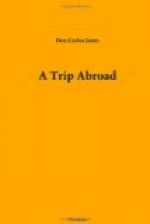That evening, the twenty-second of September, we sailed into a harbor on the island of Chios, the birth-place of the philosopher Pythagoras. It is an island twenty-seven miles long, lying near the mainland. The next morning we passed Cos and Rhodes. On this last mentioned island once stood the famous Colossus, which was thrown down by an earthquake in 224 B.C. The island of Patmos, to which John was banished, and upon which he wrote the Revelation, was passed in the night before we reached Cos. It is a rocky, barren patch of land, about twenty miles in circumference, lying twenty-four miles from the coast of Asia Minor. On the twenty-fourth the Princess Eugenia passed the southwestern end of the island of Cyprus. In response to a question, one of the seamen answered me: “Yes, that’s Kiprus.” I was sailing over the same waters Paul crossed on his third missionary tour on the way from Assos to Tyre. He “came over against Chios,” “came with a straight course unto Cos, and the next day unto Rhodes,” and when he “had come in sight of Cyprus, leaving it on the left hand (he) sailed unto Syria and landed at Tyre” (Acts 20:15 and 21:1-3).
On the evening of Lord’s day, September twenty-fifth, the ship passed Tripoli, on the Syrian coast, and dropped down to Beyrout, where I stopped at the “Hotel Mont Sion,” with the waves of the Mediterranean washing against the foundation walls. At seven o’clock the next morning I boarded the train for Damascus, ninety-one miles distant, and we were soon climbing the western slope of the Lebanon Mountains by a cog railway. When we were part way up, the engine was taken back and hitched to the rear end of the train. After we were hauled along that way awhile, it was changed back to the front end again. In these mountains are vineyards and groves of figs, olives, and mulberry trees, but most of the ground was dry and brown, as I had seen it in Southern Italy, Greece, and Asia Minor. Beyond the mountains is a beautiful plain, which we entered about noon, and when it was crossed, we came to the Anti-Lebanon Mountains, and reached the old city in the evening. Damascus, with its mixed population of Moslems, Greeks, Syrians, Armenians, Jews, and others, is the largest city in Syria, and it has probably been continuously inhabited longer than any other city on earth. Away back in the fourteenth chapter of Genesis we read of Abraham’s victory over the enemies who had taken Lot away, whom Abraham pursued “unto Hobah, which is on the left of Damascus,” and in the next chapter we read of “Eliezer of Damascus,” who Abraham thought would be the possessor of his house. Rezon “reigned in Damascus, and he was an adversary to Israel all the days of Solomon” (1 Kings 11:23-25). Elisha went to Damascus when Ben-Hadad was sick (2 Kings 8:7-15); Jeroboam recovered the city, which had belonged to Judah (2 Kings 14:28); and Jeremiah prophesied of the city (Jeremiah 49:23-27). It was probably the home of Naaman, the Syrian leper, and here Paul was baptized into Christ.




